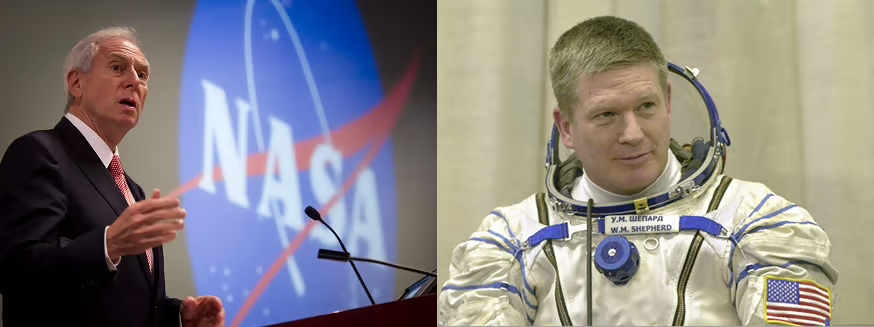Introduction
Foreword
We write as two men who spent a long season willing a stubborn thing into being. One of us, a rocket scientist turned space executive, ran the enterprise from NASA Headquarters. The other, a former Navy SEAL with a couple of engineering degrees, “forward deployed” to Star City and stayed long enough to organize, and then command, Expedition 1.

The International Space Station is usually told as détente in orbit: Soviet-American rivals turned partners, shaking hands in vacuum. And I, Dan Goldin, can’t stop telling stories about the hell Congress gave me in getting it funded (as they should, by the way).
But rarely do those who helped build and operate the Station study it as a product: a machine with users and uptime, interfaces, doctrine, and a culture that either metabolizes uphill battles or dies from them. The organizational culture that created this generational system is the overlooked half of the story.
Here are the plain facts: Most spacecraft last five to seven years in low Earth orbit. At 25 years and counting, the ISS still has modules from 1998 that are operational. More than 20 nations have contributed people, hardware, and experiments to the Station. Thousands of investigators have used the outpost to prove technologies in microgravity before they return to Earth.
The Station has been continuously inhabited since November 2, 2000, when we (Bill Shepherd, Sergei Krikalev, and Yuri Gidzenko), opened the hatch, floated inside, and started operations as Expedition 1. Nearly 300 people have now been to the ISS, and more recently, some of them have sent us social media messages from orbit, or called our homes from the cupola!

With a quarter century of continuous operations, a vast user base, and both technological and economic value that compounds year after year, in our minds, the ISS has earned the title of a generational system.
Many of you are, like us, building teams willing long-lived technologies into existence today. With the Station nearing the end of its life, we thought now was the right time to reflect on the organizational culture that made it work. What follows are the most important “product” lessons that we want to pass on to you.
– Dan and Shep
P.S. Thirty years from now, we hope you’ll file your own reflections — right here at Per Aspera — on the generational systems you built.
Section 001
Designing Against Fundamental Physics
This first point isn’t novel. But we must start here because it’s the one that teams most often forget (or subordinate to outside forces).
From the outset, we kept the ISS operating plan anchored to the physics of low Earth orbit (LEO). Physics held veto power over the plan before anything else. That sounds simple enough, but you’d be surprised how often budgets, politicians, unfounded ambition, or schedule pressures try to renegotiate with thermodynamics.
History is clear: building to the physics is not a given. It’s a management choice you must enforce every day. Never subordinate physics to org charts or other outside pressures.
In LEO, nothing ever truly rests.
For us, designing a livable habitat and scientific laboratory in LEO meant treating hostility as the default state.
- LEO has very little atmosphere, little pressure, and no natural equilibrium for you to lean on. Every 45 minutes or so, the Station swings from furnace (full sunlight) to freezer (deep darkness). The truss exhales and inhales through thermal swings of hundreds of degrees. Expansion and contraction aren’t occasional events, but rather, part of a constant fatigue cycle. Materials are never “at rest.”
- The Station’s orbit carries it through the upper fringes of Earth’s atmosphere, where atomic oxygen strips coatings, pits surfaces, and quietly, steadily eats away at your polymers and adhesives. Atomic oxygen, these highly reactive single atoms moving at orbital velocity, is continuous. The bombardment never relents.
- You must also contend with radiation: ultraviolet from the Sun, charged particles trapped in Earth’s magnetosphere, and high-energy cosmic rays from beyond the Solar System. These invisible fluxes degrade electronics, alter materials, and accumulate in bone and bodies of the crew.
- Don’t forget about debris, from micrometeoroids to orbital waste fragments. A paint chip carries the energy of a high-caliber rifle round, and every square meter of the pressurized vessels is at risk of puncture or impact. You learn to think of the whole outpost as a pressure vessel under fire.
- And there’s the quiet tyranny of vibration. If you want to do real microgravity research, in some cases, you must ensure your onboard accelerations and vibrations do not exceed one-millionth of Earth’s gravity (10⁻⁶ g). This is an extraordinarily tight tolerance.
The Non-Negotiables
So, from this exceptionally harsh environment flowed a list of irreducible modules that our station needed:
- “Sky hook.” A foundational structural module that other systems can attach to, that provides power, attitude control, and life support.
- Docking system. A pressure-rated, operationally reliable docking mechanism is essential for crew transfer and system integration. (This included interface compatibility with the Space Shuttle, Soyuz, and Progress space vehicles, as well as Dragon, Cygnus, and Starliner later on.)
- Robotic arm. Required for on-orbit assembly, maintenance, and handling large payloads. The arm enabled in-orbit construction and long-term operations.
- Crew escape vehicle. A standing “rescue” option so that pressure loss or major system failure does not leave the crew trapped onboard.
- Hab module. A fully capable habitation module must support daily life and work.
- Power. We needed a robust source of power, which meant designing, deploying, and continuously operating the largest electrical system ever flown in space.

Each of these fundamentals was shaped not by internal or external politics, but by the physical laws of Earth orbit and the core requirements of putting a system for living and working in space. You earn the right to argue about everything else by getting those right.
Which brings us to our next point: getting the physics right means getting the people operations right.
Section 002
Forward Deploy Your People (and Backward Deploy Into Your People)
By 1992, the verdict was clear. The United States wouldn’t be building a station by ourselves. Space Station Freedom, announced with fanfare in 1984, had already tapped its $11.2 billion budget. The program didn’t have a single flight article to show for it, not even the “sky hook” that you need to start the whole business.
Meanwhile, a world over, the newly formed Russian Federation had what we lacked.

Our American muscle memory was Skylab: gutsy, monolithic, unextendible. The Soviets had pioneered a different approach. Salyut taught them to think in modules. Mir, launched in 1986, truly proved it was possible to scale this approach to a large, longe-lasting, multi-module station in orbit. Mir had propulsion, life support, docking hubs, electrical power, autonomous control, and a constant human presence. It was the only working, available blueprint for how to assemble and operate a real station. We didn’t need to admire it; we needed to learn from it.
We formed an unprecedented partnership in 1992 with the Russian Space Agency in 1992, and initially agreed to dock the U.S. Space Shuttle with the Russian Mir Space Station.
In 1993, we made our pivot official.
Space Station Freedom would become the International Space Station, and our initial partnership was expanded to merge American, Russian, European, Canadian, and Japanese manned space station efforts under one umbrella.

The geopolitics were no small thing. There was a conscious decision, championed by my (Dan’s) boss, President George H.W. Bush, and others, not to grind a wounded nation into bitterness. We had an instructive precedent close at hand: the punitive aftermath of WW1, which helped seed resentment that set the stage for Nazi Germany. To his credit, President Bush didn’t want to make that same mistake again with post-Soviet Russia. President Clinton followed through with the directive for NASA to work with our partners to produce and operate the ISS.
What’s not commonly appreciated (or even remembered)?
The partnership was not just diplomacy with a view, or an olive branch to our fellow space agencies. It was fundamentally strategic in nature. Recall that we did not have a skyhook, that we were $11.2B in the hole, and that we had said we were going to build the Station.
To get moving, we needed modules, docking systems, manufacturing capacity, and the tribal knowledge of crews who had already lived with all of it. Russia had those. The only way forward was together.
“Together” had to become literal, fast. Overnight, we were both buyer and seller, importing foreign flight articles while exporting American avionics, robotics, procedures, and people. The architecture became deliberately interdependent: Zarya for initial power and propulsion; Unity to marry segments; Zvezda for station control and life support; Destiny as the American lab; Canadarm2 to do the heavy lifting; Columbus and Kibō bringing European and Japanese science online; nodes, airlocks, docks, and adapters stitched into a single pressure vessel that spoke five languages and shared one heartbeat. Interdependence built redundancy and underwrote our insurance policy: if one nation slipped, the outpost didn’t.
Needless to say, this degree of integration was not as simple as signing an agreement and swapping jerseys.
With as broad of a contributor base as the one shown above, you get a dizzying spectrum of design philosophies, manufacturing practices, and user cultures. This was a diffuse web of supply chains and contracts, but also a convergence of how different Cold War-era space powers built, tested, operated, and lived inside their systems. With the full inheritance of Cold-War spacefaring, treating partners like vendors and meetings like diplomacy would have doomed us.
The only workable doctrine was immersion.
We started with what you might call “backward deployment,” bringing Russian scientists and engineers to Crystal City, VA, where they embedded directly into our NASA-led redesign process just across the river from agency HQ. They weren’t brought on as back benchers, but in decision seats. We argued in mixed languages, in real time, through the pivotal turn from Freedom to ISS.
Even more critically, we forward-deployed into the Russian space system. We pulled Bill Shepherd off the redesign team and sent him straight to Star City, outside Moscow. His marching orders: make the Station and its crew ready to operate in space. Train with them; walk the factory floors at Energia and Khrunichev; confirm that the hardware did what the drawings promised; and surface the mismatches early enough to fix them.

Shep packed a bag for Star City and embedded there for years. He learned the Russian system, working side-by-side with cosmonauts, engineers, and industrial players. As Russian managers became comfortable that Shep and his crew were an effective team, he was afforded exceptional access to sensitive Russian manufacturing.
The people you deploy matter more than the gesture. In the Russian system of the early ‘90s, there were “cosmonauts” and there were “guest cosmonauts,” a second-class label for foreigners. Initially, the Russians tagged Shep as a “guest cosmonaut.” He refused to accept this label, instead insisting: “I am going to be treated like every other cosmonaut on the crew.”
This two-tier system was wholly incompatible with how we at NASA believed an international crew must train and operate on orbit. Shep and his cosmonaut crewmates persuasively pushed to be cross-qualified so that any member of the crew could execute any critical task on Russian or American hardware, without regard to country.
“If you radio up to the station and ask for something to be worked on, it shouldn’t matter who does it. We all carry the same responsibility to get it done”.
Bill Shepherd
Responsibility is a quiet word until you must spend it in front of a room. On the eve of flight, at a high-level prelaunch meeting, a Russian aerospace chief still hadn’t resolved a lingering contract issue with Shep’s two cosmonauts. Shep stood up in front of the entire room and, in Russian, read him the Riot Act, making clear that crew safety and well-being were his to own, and that someone else not doing their job was unacceptable.
Politicians did what politicians do. Members of the Duma accused Washington of “taking over the Russian space program” and balked at the prospect of an American commander. We read that anger as a diagnostic, not a scandal: you don’t get that kind of heat unless you’re embedded deeply enough to matter.
And this was not liaison work. Shep, his U.S. backup, and his small NASA support team trained, lived, and operated as an integral part of the Russian system. They didn’t represent the U.S. from the sidelines. That level of immersion was the only way to build real trust, which was the only way the mission could succeed.
“We needed years to build the trust of the first crew in space and on the ground. And we couldn’t have done it without forward deploying people like Shep.”
Dan Goldin
It was this aggressive intermingling of teams that allowed the ISS to become what it is today. We embedded so deeply it rattled American lawmakers and Russian parliamentarians, but the political theatrics were downstream of real integration.
The result was not a U.S. outpost with visiting dignitaries, but a fully integrated machine with a shared multinational culture (training, operations, command). Astronauts from Europe, Japan, Canada, Russia, and the U.S. have taken their turns in command of ISS, a vehicle assembled from dozens of organizations, languages, and engineering doctrines. The spacecraft has flown for 25+ years without a serious incident or failure, in spite of the many nations, agencies, primes, and subs involved.
Section 003
(Squeaky) Clean Lines of Authority
The “fun” parts of building the ISS were embedding into partner agencies, learning new cultures, and finding common ground. Less fun were the conversations around establishing clear lines of authority across vendors, partners, and even amongst ourselves. These were difficult confrontations: Who gets to say no? Who gets paid, under what conditions? Who owns the call when the room goes quiet?
Trust is one part of creating a successful system, but accountability is also table stakes for keeping the machine moving (or even getting it off the ground). Here’s how we developed accountability, and squeaky-clean lines of authority, in practice:
1 / A single person is in charge.
Start with the simplest sentence in program management: one person is in charge.
When we took charge of the program in the early 1990s, the American station effort had no real authority structure. NASA had carved the program into four different centers: Johnson in Houston for human systems/ops, Marshall in Huntsville for pressurized structures and modules, Lewis (now Glenn) in Cleveland for power systems, and a new Virginia office working on “systems integration.” Each center had separate budget lines, contractor stables, and definitions of success. It was a headless horseman, where everyone had turf and nobody had accountability.
The first order of business was to change that. We collapsed the ambiguity and consolidated authority inside NASA: one accountable program manager, a clear chain of command, and an empowered integration office that could actually say yes or no.
2 / $$$$ should be tied to performance.
The second step was reforming contractor accountability. At Johnson, award fees were running at 96% ratings despite hardware that was late and over budget. This came to an immediate halt. Performance fees were tied directly to results: deliver the module, meet the spec, hit the schedule, or lose your award. Discipline returned, and a few new enemies emerged in Houston and on Capitol Hill. With a single point of authority having been established, NASA selected Boeing as the prime contractor. Imperfect, yes, but there was finally a single industrial entity responsible for pulling together hardware from dozens of subcontractors and multiple nations. If something wasn’t working, we knew exactly where the accountability lay. Boeing stepped up to its very large leadership role and delivered the goods in true and respected partnership with NASA.
3 / One plan, one boss.
The third step was ensuring that authority would be just as crisp on orbit. Responsibility fell squarely on Shep’s shoulders to set the precedent as the first ISS commander.
On Shuttle missions, crews had little discretion. Houston directed almost everything, minute by minute. But the early days of ISS were different. Dozens of systems were running simultaneously, with two mission control centers — Houston and Moscow — both sending commands, instructions, and operational changes.
In the first days of Expedition 1’s mission, the crew got caught in the middle of this disconnect. Each morning, the crew reviewed changes to their schedules that had been sent up from the ground overnight. During the short communications passes throughout the day, Houston and Moscow were each sending new changes to the day’s plans. Many times, the new instructions received were uncoordinated and conflicting. For nearly a week, the crew tried to juggle two sets of orders. It was unsustainable.
Finally, Shep got on the comms loop, with both control centers listening, and laid down the law. “We are not going to do one plan for Houston and another for Moscow” he said. “We are an International Space Station. You get together, decide on one plan, and send it up. Space Station, out.”
4 / Leadership needs situational awareness.
Finally, we had to match command to reality. Shuttle doctrine assumed near-continuous comms and heavy ground intervention. Mission Control did all the planning and the real-time execution for each flight. In a typical Shuttle mission day, hundreds of ground commands were sent directly to the Shuttle’s systems. From the outset, ISS was destined to be different. It was a permanently crewed outpost, built up piece by piece, with orbital passes that often had no radio contact with the ground for up to six hours.
Shep realized early in his training that ISS had to be run differently than Shuttle flights. Houston’s habit of queuing commands to be transmitted right after the short Shuttle LOS (loss of signal) periods wasn’t going to cut it for the Station. In that silence, there was a good chance that preplanned commands without up-to-date knowledge of the situation onboard could do more harm than good. The Expedition 1 crew helped create a new rule: onboard and ground teams needed shared situational awareness before automatic changes were sent up from Earth.
The ISS commander’s authority had to be broader, because of the sparse communications. As a result, today, the ISS commander has full authority to do whatever is necessary to protect the crew, the vehicle, and the mission…whether the crew is in contact with the ground or not.
“You get together, decide on one plan, and send it up. Space Station, out.”
Forward deployment of personnel built trust, and clear lines of authority built accountability.
Within NASA, we consolidated four fiefdoms into a single program. We paid contractors for results and named a single integrator. On orbit, Shep forced Houston and Moscow to work together and subordinated their authority to that of the Station commander when situations called for it.
Trust made the partnership possible; squeaky clean lines of authority made it durable.
That is why, after 25 years, the ISS still operates without a major failure. Not because problems never arose, but because when they did, there was never confusion about who owned the fix. Authority was clarified, accountability enforced, and responsibility shouldered. That clarity is the reason a machine built by dozens of nations, hundreds of vendors, and thousands of people has endured far beyond its design life.
Section 004
Test, test, test
Returning to our fundamental theme of Section 002, the deeper challenge wasn’t knowing the physics, but enforcing a culture that stayed rooted in it over five, ten, then fifteen years, especially as “shouldering” the boulder of a program that felt heavier and heavier.
Every team starts out saying “of course we’ll follow the physics.”
The real challenge is making that discipline last.
How we enforced a culture of fundamental physics: testing, testing, testing.
The more important point here is how you enforce a culture of fundamental physics. And that really comes down to testing, testing, testing.
And in anticipation of failure: build redundancies.
Just as important as testing was redundancy. We engineered the Station to be dual-fault tolerant, meaning it could sustain two critical failures and still survive.
Every major system had backups, and many had backups to the backups. We also designed the ISS to be maintainable in orbit: crews could swap out pumps, replace computers, or reroute fluid loops when things broke.
This mindset also extended to the ground. Within months of the U.S.–Russian partnership, Americans moved to Moscow and Russians relocated to Houston, each side duplicating mission control capability. We built two fully staffed ground teams, each capable of running the Station if the other went dark.
What emerged was redundancy as a governing principle. The ISS incorporated multiple technologies from different continents, multiple launch vehicles and facilities for crew and cargo transport, and multiple control centers that could take over operations. This was redundancy as statecraft, as survival strategy, as the very architecture of permanence.
This multi-layered approach, spanning hardware, software, geography, and international partnerships, became the foundation of the Station’s remarkable safety record, operational longevity, and scientific productivity over 25 years.
Section 005
Wrap: These were the basics
What we hope you take away is that even for those of us who lived it, the International Space Station was not a triumph of exotic technical sophistication, but of getting the fundamental people engineering right.
The individuals involved were certainly world-class. But more important than any lone genius was our collective discipline in working together across languages, time zones, and the weight of history. That discipline is the path to generational achievement. Those who have pursued such technologies probably carry enough scar tissue to know that they don’t emerge and endure from chasing the fancy, but from nailing the basics.
We could fill volumes with the stories we haven’t told. Getting caught in the Russian coup of 1993 and ripping seats from a military transport to evacuate NASA crews. Forcing the hand of former Soviet military officials to make sure Russian cosmonauts got paid. The thousand small crises that threatened to unravel everything, and the thousand small acts of partnership that held it together.
Those are stories for another day. What matters now is what you’ll build with these lessons. The Station taught us that the most audacious dreams require the most mundane virtues: showing up, staying humble, trusting your partners, drawing those squeaky-clean lines, and never forgetting that physics doesn’t negotiate.
The rest is up to you.

What’d we miss?
If you worked on the ISS and have stories or lessons to share, send us a note. We’ll figure out a way to update our collective experiences and pass it forward to our community as you send vignettes in. And if you’re not signed up for Per Aspera, there’s no time like the present to fix that!
